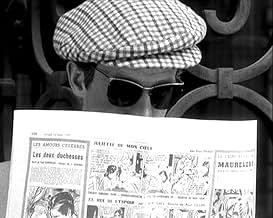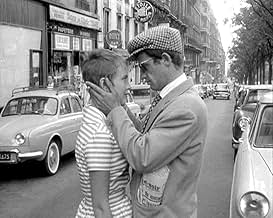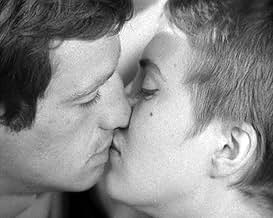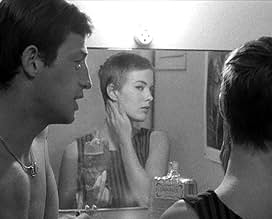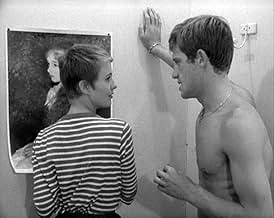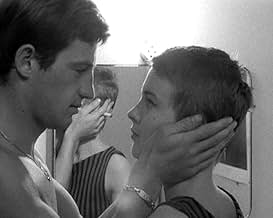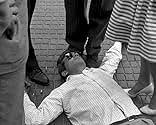À bout de souffle
- 1960
- Tous publics
- 1h 30min
NOTE IMDb
7,7/10
92 k
MA NOTE
Un petit escroc vole une voiture et assassine impulsivement un policier. Recherché par les autorités, il retrouve une étudiante américaine en journalisme et tente de la persuader de s'enfuir... Tout lireUn petit escroc vole une voiture et assassine impulsivement un policier. Recherché par les autorités, il retrouve une étudiante américaine en journalisme et tente de la persuader de s'enfuir avec lui en Italie.Un petit escroc vole une voiture et assassine impulsivement un policier. Recherché par les autorités, il retrouve une étudiante américaine en journalisme et tente de la persuader de s'enfuir avec lui en Italie.
- Réalisation
- Scénario
- Casting principal
- Nomination aux 1 BAFTA Award
- 5 victoires et 4 nominations au total
Jean Seberg
- Patricia Franchini
- (non crédité)
Richard Balducci
- Tolmatchoff
- (non crédité)
Daniel Boulanger
- Police Inspector Vital
- (non crédité)
Gérard Brach
- Photographer
- (non crédité)
Philippe de Broca
- A Journalist
- (non crédité)
José Bénazéraf
- Man in a White Car
- (non crédité)
Jean Domarchi
- A Drunk
- (non crédité)
Jean Douchet
- A Journalist
- (non crédité)
Liliane Dreyfus
- Liliane
- (non crédité)
- …
Michel Fabre
- Police Inspector #2
- (non crédité)
Jean-Luc Godard
- The Snitch
- (non crédité)
Roger Hanin
- Carl Zubart
- (non crédité)
Henri-Jacques Huet
- Antonio Berrutti
- (non crédité)
Raymond Huntley
- A Journalist
- (non crédité)
André S. Labarthe
- Journalist at Orly
- (non crédité)
Avis à la une
10IZMatt
I don't blame those who state that they do not "understand" the superlatives surrounding Jean-Luc Godard's 1960 masterpiece, Breathless. It's primarily because to appreciate Breathless, one has to view the movie from a historical context, which also requires studying of not only the French New Wave, but film theories as a whole, and the lives of those apart of the New Wave. Breathless accomplished many things unprecedented prior (many completely unprecedented, but some things are not-so-much).
Roger Ebert put it best when he said that just as film fanatics may now stand outside a movie theatre waiting for the next Quentin Tarantino movie to be released, film enthusiasts were doing so for Godard in the 1960s. He was a revolutionary, which is why MovieMaker magazine called him the 4th most influential director of ALL-TIME (only behind Welles, Griffith, and Hitchcock)! What did Godard do different? Breathless is all style, simple as that. The story line is interesting, yes, but is Godard's aesthetics, production modes, subject matters, and storytelling methods that are key. First of all, the whole movie was shot on a hand-held camera, just like most all New Wave pictures. It was, however, only shot by two people (Godard and his cinematographer, Rouald) on a budget that did not top $50,000, a mere fraction of what most pictures cost at the time (another facet of the New Wave). It was shot completely on location in Paris, and utilized new film-making techniques that would be used by film-making students for decades to come (such as putting the camera in a mail cart on the Champs Elysees and following Belmondo and Seberg). Note Godard's use of American cinema influence, and how the montage art of the 1950s impacted this aesthetic.
(A brief New Wave lesson: Most New Wave directors were displeased with the "tradition of quality," or the older generation directors who, as Truffaut put it, made the "twelve or so" pictures per year that represented France at Venice and Cannes. Most of these pictures classic or modern literary adaptations, completely stagnant in artistic quality with rehashed subject matters based on historical periods. New Wave directors supported NEW tales of modern Parisian life, primarily, and were sick of the themes found in the tradition of quality films.) The storytelling methods in Breathless are perhaps the most fascinating part of the film. The jump cuts may seem lame, but one must again view them from a historical context: it had never been done before. This is exactly why Breathless is important -- practically every technique was revolutionary. They are so submerged into film-making practices now that Breathless seems typical. Yet at the time, it was, as I said prior, unprecedented.
Roger Ebert put it best when he said that just as film fanatics may now stand outside a movie theatre waiting for the next Quentin Tarantino movie to be released, film enthusiasts were doing so for Godard in the 1960s. He was a revolutionary, which is why MovieMaker magazine called him the 4th most influential director of ALL-TIME (only behind Welles, Griffith, and Hitchcock)! What did Godard do different? Breathless is all style, simple as that. The story line is interesting, yes, but is Godard's aesthetics, production modes, subject matters, and storytelling methods that are key. First of all, the whole movie was shot on a hand-held camera, just like most all New Wave pictures. It was, however, only shot by two people (Godard and his cinematographer, Rouald) on a budget that did not top $50,000, a mere fraction of what most pictures cost at the time (another facet of the New Wave). It was shot completely on location in Paris, and utilized new film-making techniques that would be used by film-making students for decades to come (such as putting the camera in a mail cart on the Champs Elysees and following Belmondo and Seberg). Note Godard's use of American cinema influence, and how the montage art of the 1950s impacted this aesthetic.
(A brief New Wave lesson: Most New Wave directors were displeased with the "tradition of quality," or the older generation directors who, as Truffaut put it, made the "twelve or so" pictures per year that represented France at Venice and Cannes. Most of these pictures classic or modern literary adaptations, completely stagnant in artistic quality with rehashed subject matters based on historical periods. New Wave directors supported NEW tales of modern Parisian life, primarily, and were sick of the themes found in the tradition of quality films.) The storytelling methods in Breathless are perhaps the most fascinating part of the film. The jump cuts may seem lame, but one must again view them from a historical context: it had never been done before. This is exactly why Breathless is important -- practically every technique was revolutionary. They are so submerged into film-making practices now that Breathless seems typical. Yet at the time, it was, as I said prior, unprecedented.
Jean-Luc Godard intended to shake the delicate world of cinema, that much is obvious. But did he intend to reinvent it? Whether it was his intention or not isn't the point, the point is this; he did. Jean-Luc Godard, and Francois Truffuat are the undisputed fathers of the French New Wave. Some cinephiles or historians may feel like pointing elsewhere, to Jean Renoir for example, protesting that he is truly the father of the French New Wave, I disagree entirely. The French New Wave was a product of the kindred spirits and talents of Godard and Truffaut. And no other film represents the French New Wave more coherently than Jean-Luc Godard's dazzling 1960 picture, 'Breathless'. Unorthodox and uninhibited. Raw and experimental. Godard broke every rule in the book, disavowed the laws of cinema, and scribed a new rule book, one where the pages are blank, and possibilities are endless. The story is so simple I can summarize the entire film in half of a sentence, but I refuse to give you or Godard the satisfaction. What counts in Breathless is not the story, but how the story is told. The very definition of 'cool', the film is robust in creativity, and exuberant in its flaws, and passionate about its reckless behavior. Self aware and rebellious. If there was no breathless, there would have been no Tarantino, if there was no French New Wave, the streak of genius that ran through the nineties and 2000s wouldn't have existed. Before Breathless, it was believed that films took money, that you had to find yourself in a place of authority to make a film. Breathless broke this misconception. Breathless makes you want to run outside and make the film of your life. Breathless made that possible, Breathless made the amateur the auteur, Breathless reinvented the face of the cinema, and made you believe that could too. All you need is a girl and gun.
There's a rogue with several pseudonyms in tow, a small time crook who several girls think is a beau, not the most, trustworthy guy, he'll spin a yarn or two and lie, so be careful where you keep your hard earned dough. He's been known to shoot and kill with firearm, after being chased by the local gendarme, so he's off to Italy, when he's collected fiscally, will take Patricia, who's been caged by Gallic charm.
Still a wonderful introduction to the world of French cinema of the time, but needs to be taken in context as familiarity breeds contempt and this was, after all, part of the foundations and a cornerstone of so much of what was to come. Imaginatively and innovatively directed by one of the greatest, with two flowers of the 60s revealing their early petals, and after smoking so many cigarettes, is it any wonder you'd struggle to catch your breath!
Still a wonderful introduction to the world of French cinema of the time, but needs to be taken in context as familiarity breeds contempt and this was, after all, part of the foundations and a cornerstone of so much of what was to come. Imaginatively and innovatively directed by one of the greatest, with two flowers of the 60s revealing their early petals, and after smoking so many cigarettes, is it any wonder you'd struggle to catch your breath!
I finally did it. I finished watching À bout de souffle. I kept putting it off because I usually have problem when everybody tells me that such and such film is the epitome of its era or it breaks all the rules, starts the revolution, and reinvents the cinema. That's why, probably, I cannot like Citizen Kane - try to watch the arguably best film ever made - you will be under a lot of pressure.
Well, À bout de souffle does not put you under the pressure, it takes you for a ride, and you follow for 90 minutes its incredibly young characters, common crook (Jean-Paul Belmondo) and his American free-spirited girlfriend (Jean Seberg) on their journey on the streets of 1960-th Paris along with Raoul Coutard's legendary camera. I am not going to tell here how great the camera work was, how fantastic the music score and the views of Paris were - the fans of the film know that already. They also know about the beginning of French New Wave, and how it influenced the future cinema. I just want to say that the movie was made over forty years ago - the smoking was cool back then, and Belmondo made smoking look very sexy. Belmondo fascinates me in this film. I've seen him in a lot of later movies - he's always been good (I recommend Le Magnifique, 1973 and Le Professionnel,1981 ) - but in À bout de souffle he is not just good - he is embodiment of cool, his face changes its expression every moment, you can not take your eyes off him. Is it me or he does remind the very young Mick Jagger - not commonly handsome but irresistible and sexy? He and young (she was 21 at the time) Jean Seaborg made one of the best screen couples ever. My favorite scenes:
Michel drives the stolen car in the beginning of the film, and he starts to talk to us, the audience. The day is nice, the sun is shining, and the life is beautiful...
Michel and Patricia drive in the convertible. The wind plays with her short hair. We only see the back of her head and her neck. Michel tells her that he loves the girl with a beautiful neck, wrists, knees, but she is a chicken...
Patricia comes to the hotel to find Michel in her bed. They start talking about nothing and about very serious things. They smoke, she tries to find a good place for her new poster, and he wants to sleep with her. In the end of the scene, his face, he looks at her - there is love in that look...
There is more - I am sure everyone who saw it has his/her favorite scenes.
Well, À bout de souffle does not put you under the pressure, it takes you for a ride, and you follow for 90 minutes its incredibly young characters, common crook (Jean-Paul Belmondo) and his American free-spirited girlfriend (Jean Seberg) on their journey on the streets of 1960-th Paris along with Raoul Coutard's legendary camera. I am not going to tell here how great the camera work was, how fantastic the music score and the views of Paris were - the fans of the film know that already. They also know about the beginning of French New Wave, and how it influenced the future cinema. I just want to say that the movie was made over forty years ago - the smoking was cool back then, and Belmondo made smoking look very sexy. Belmondo fascinates me in this film. I've seen him in a lot of later movies - he's always been good (I recommend Le Magnifique, 1973 and Le Professionnel,1981 ) - but in À bout de souffle he is not just good - he is embodiment of cool, his face changes its expression every moment, you can not take your eyes off him. Is it me or he does remind the very young Mick Jagger - not commonly handsome but irresistible and sexy? He and young (she was 21 at the time) Jean Seaborg made one of the best screen couples ever. My favorite scenes:
Michel drives the stolen car in the beginning of the film, and he starts to talk to us, the audience. The day is nice, the sun is shining, and the life is beautiful...
Michel and Patricia drive in the convertible. The wind plays with her short hair. We only see the back of her head and her neck. Michel tells her that he loves the girl with a beautiful neck, wrists, knees, but she is a chicken...
Patricia comes to the hotel to find Michel in her bed. They start talking about nothing and about very serious things. They smoke, she tries to find a good place for her new poster, and he wants to sleep with her. In the end of the scene, his face, he looks at her - there is love in that look...
There is more - I am sure everyone who saw it has his/her favorite scenes.
This is the one that started it all kids, the daddy of post-modern cinema. MTV jump cuts, fractured soundtrack and images aplenty
Self reflexive to the point that it not only acknowledges its own existence, it revels in it.
All style and no substance is considered a bad thing today, unless its Tarantino. Well, if it wasn't for Godard, chances are there would be no QT.
All the characters and images, and dialogue and sets are constructed from all aspects of life - Michel is a Bogart collage. Patricia apes everything she sees, from her Interviewee's facial gestures to Michel's own.
Don't let all this technical mumbo fool you, I did my thesis on Godard and would happily bore the ass off you with a lecture in great detail about this film, but the fact is, it's a stormer.
Grips you by the throat and shakes the hell out of you, and it doesn't let go until the final breath.
Fantastically, artistically magnificent. If Godard wanted to make his debut picture to show how well he understood American ideals and the history of cinema, he couldn't have made a better picture.
Top stuff French guy.
Self reflexive to the point that it not only acknowledges its own existence, it revels in it.
All style and no substance is considered a bad thing today, unless its Tarantino. Well, if it wasn't for Godard, chances are there would be no QT.
All the characters and images, and dialogue and sets are constructed from all aspects of life - Michel is a Bogart collage. Patricia apes everything she sees, from her Interviewee's facial gestures to Michel's own.
Don't let all this technical mumbo fool you, I did my thesis on Godard and would happily bore the ass off you with a lecture in great detail about this film, but the fact is, it's a stormer.
Grips you by the throat and shakes the hell out of you, and it doesn't let go until the final breath.
Fantastically, artistically magnificent. If Godard wanted to make his debut picture to show how well he understood American ideals and the history of cinema, he couldn't have made a better picture.
Top stuff French guy.
Le saviez-vous
- AnecdotesDespite reports to the contrary, Jean-Luc Godard did not shoot the film without a script; however, he did not have a finished script at the beginning, instead writing scenes in the morning and filming them that day. See also Pierrot le fou (1965).
- GaffesDuring street shots, countless passersby look at Patricia and Michel and stare into the camera, revealing that the shots were made without filming barriers and simply used street pedestrians in place of extras.
- Citations
Patricia Franchini: What is your greatest ambition in life?
Parvulesco: To become immortal... and then die.
- ConnexionsEdited into Pariz pripada nama! (2016)
Meilleurs choix
Connectez-vous pour évaluer et suivre la liste de favoris afin de recevoir des recommandations personnalisées
Détails
- Date de sortie
- Pays d’origine
- Langues
- Aussi connu sous le nom de
- Sin aliento
- Lieux de tournage
- 11 rue Campagne Première, Paris 14, Paris, France(on location)
- Sociétés de production
- Voir plus de crédits d'entreprise sur IMDbPro
Box-office
- Budget
- 400 000 F (estimé)
- Montant brut aux États-Unis et au Canada
- 414 173 $US
- Week-end de sortie aux États-Unis et au Canada
- 32 424 $US
- 30 mai 2010
- Montant brut mondial
- 596 100 $US
- Durée1 heure 30 minutes
- Couleur
- Mixage
- Rapport de forme
- 1.37 : 1
Contribuer à cette page
Suggérer une modification ou ajouter du contenu manquant





